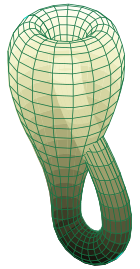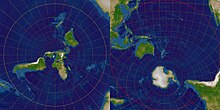
Back Mannigfaltigkeit ALS متعدد شعب Arabic Çoxobrazlı Azerbaijani Многообразие Bulgarian বহুভাঁজ Bengali/Bangla Varietat (matemàtiques) Catalan Varieta (matematika) Czech Нумайсăнарлăх CV Mangfoldighed (matematik) Danish Mannigfaltigkeit German
This article includes a list of general references, but it lacks sufficient corresponding inline citations. (July 2021) |


In mathematics, a manifold is a topological space that locally resembles Euclidean space near each point. More precisely, an -dimensional manifold, or -manifold for short, is a topological space with the property that each point has a neighborhood that is homeomorphic to an open subset of -dimensional Euclidean space.
One-dimensional manifolds include lines and circles, but not self-crossing curves such as a figure 8. Two-dimensional manifolds are also called surfaces. Examples include the plane, the sphere, and the torus, and also the Klein bottle and real projective plane.
The concept of a manifold is central to many parts of geometry and modern mathematical physics because it allows complicated structures to be described in terms of well-understood topological properties of simpler spaces. Manifolds naturally arise as solution sets of systems of equations and as graphs of functions. The concept has applications in computer-graphics given the need to associate pictures with coordinates (e.g. CT scans).
Manifolds can be equipped with additional structure. One important class of manifolds are differentiable manifolds; their differentiable structure allows calculus to be done. A Riemannian metric on a manifold allows distances and angles to be measured. Symplectic manifolds serve as the phase spaces in the Hamiltonian formalism of classical mechanics, while four-dimensional Lorentzian manifolds model spacetime in general relativity.
The study of manifolds requires working knowledge of calculus and topology.
© MMXXIII Rich X Search. We shall prevail. All rights reserved. Rich X Search
